Transition Period
Author:
Unlock your full potential by engaging with our experts and community! Have questions about your fitness journey or looking for expert advice on weightlifting techniques? Don’t hesitate — leave a comment below and Sergii Putsov will provide a personalized answer and insights to help you reach your goals.
Torokhtiy is reader-supported. Some links are affiliate links, and we may earn a commission at no extra cost to you. See our disclosure page for details.
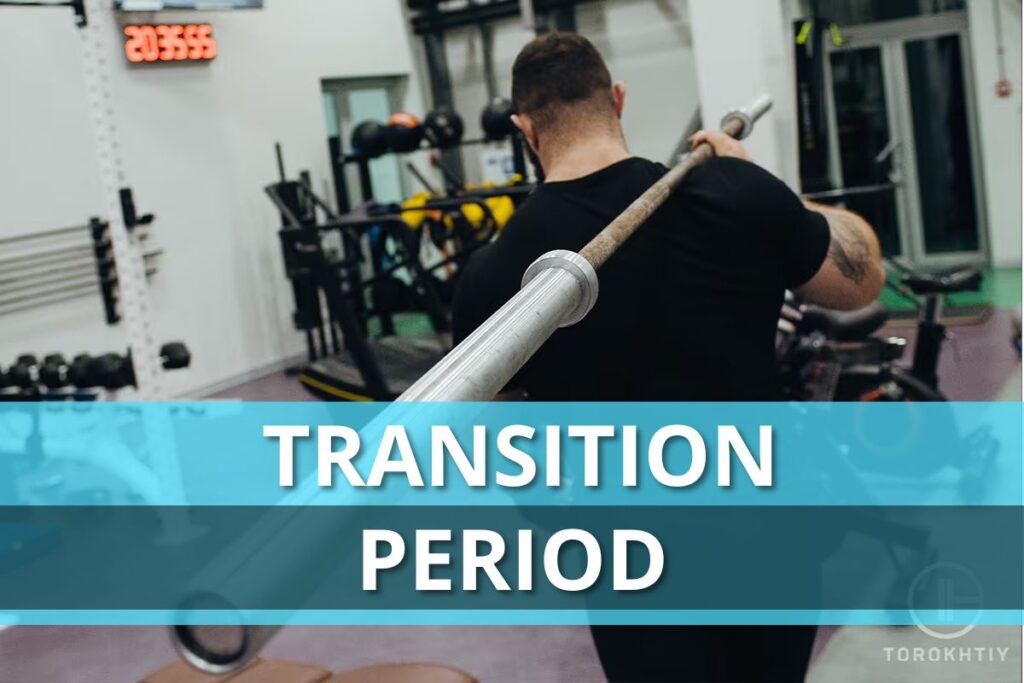
Unfortunately or fortunately, no training program can last forever and after the next stage of preparation, which can last 2-3 months, the athlete performs in competitions. Regardless of whether he has achieved the planned result or not, there comes a transitional period. This training period is not secondary, as many novice athletes think. Rather, it is very important and in this article, I will try to tell you why.
The main tasks of the transition period include proper rest after training and competitive loads, as well as maintaining a certain level of fitness to ensure optimum readiness for the next training start. Special attention should be paid to full physical and mental recovery. These tasks determine the duration of the transition period, the dynamics of loads.
Modern weightlifting is characterized by a tendency to reduce the transition period and to exclude passive rest from it. If in previous years the duration of the transition period often reached 1.5–2 months, then in the present it is usually limited to 2–4 weeks. This is due to the expansion of the competitions calendar, with the need to allocate time for the preparatory period. The shortening of the transition period and the increase in it of various types of motor activity is also due to the need for prevention of badly adapting energy supply systems.
Follow us!

Free!
Get a 2-week Weightlifting Program as a bonus for the subscription to kickstart your training plan!

Free!
You may like it:
- Detailed Olympic Weightlifting Program For Beginners
- 12-Week Weightlifting Program For Women (Detailed Example)
- Create Your Olympic Weightlifting Program (Examples Included)
At the same time, I want to note that historically there have been cases when some world-class athletes took a timeout of 8-12 months after long and exhausting preparations for the Olympic Games, which could consist of 2-3 continuous annual training cycles, who then returned successfully to the “big platform” and won medals. But I would consider it rather an exception, and I do not recommend this approach to athletes without a great deal of experience.
So, the first 5-7 days of the transition period can be completely subordinated to active rest, training exercises with a barbell should be excluded (yes, you also need to rest from it, both body and mind), diversify the way of life as much as possible with the goal of full physical and mainly mental recovery. From my own experience, I can say that muscles recover much faster than “mind”. For psychological rest, it is important to temporarily remove the classic load and “change your training routine.”
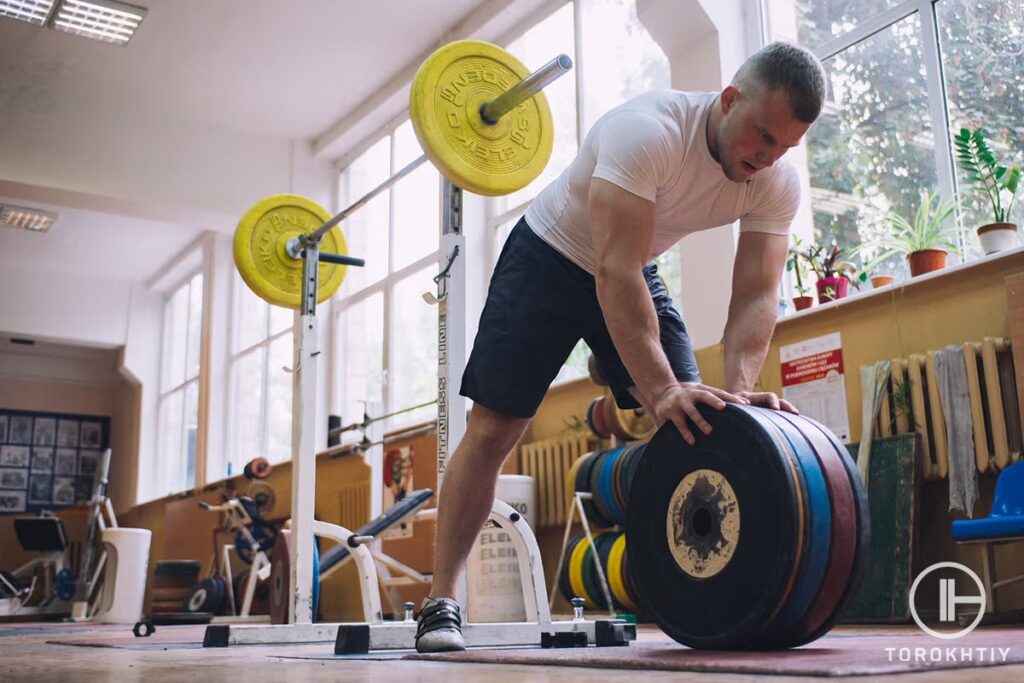
Training in the transition period is characterized by a small total amount of work and minor loads. The amount of work compared to the preparatory period is reduced by 60-80%; the number of sessions per weekly microcycle does not exceed 2-4; sessions with large loads are not planned. The direction of work also changes dramatically. The main content of the transition period consists of various means of active rest and general preparatory exercises. At the same time, in the process of both active recreation and the use of general physical training facilities, it is advisable to focus on new points that were not widely used in the previous training.
Various sports games can be used for outdoor activities: football, basketball, and so on. Strangely enough, many weightlifters love volleyball and table tennis, swimming, various types of functional training in a reasonable amount. Such workouts are quite engaging but do not overload the athlete’s mind, and their diversity allows you to maintain the level of fitness.
Weightlifters hardly ever, and without much enthusiasm, use aerobic exercises in their training process, especially running. But during the transition period, this type of activity is quite acceptable. For example, the famous Soviet weightlifter Anatoly Pisarenko (+110 kg) in the transition period ran 7-8 km in the forest, and in winter went 12-15 km on cross-country skis. And this did not prevent him from setting a world record in the 265 kg clean & jerk. Let me remind you that the medical standard on cardio load – 10,000 steps a day – is a requirement for everyone, including weightlifters.
As for the exercises from the weightlifting arsenal, I would recommend removing all dynamic exercises (that is, those that include power position and drive). Full muscle snatch, clean, hang clean, standing press, sitting, inclined bench press, middle grip deadlifts from the hang position, different variations of good mornings and split squats. Light and medium loads are planned during this period, the number of reps should be 4-8, 2-4 sets.
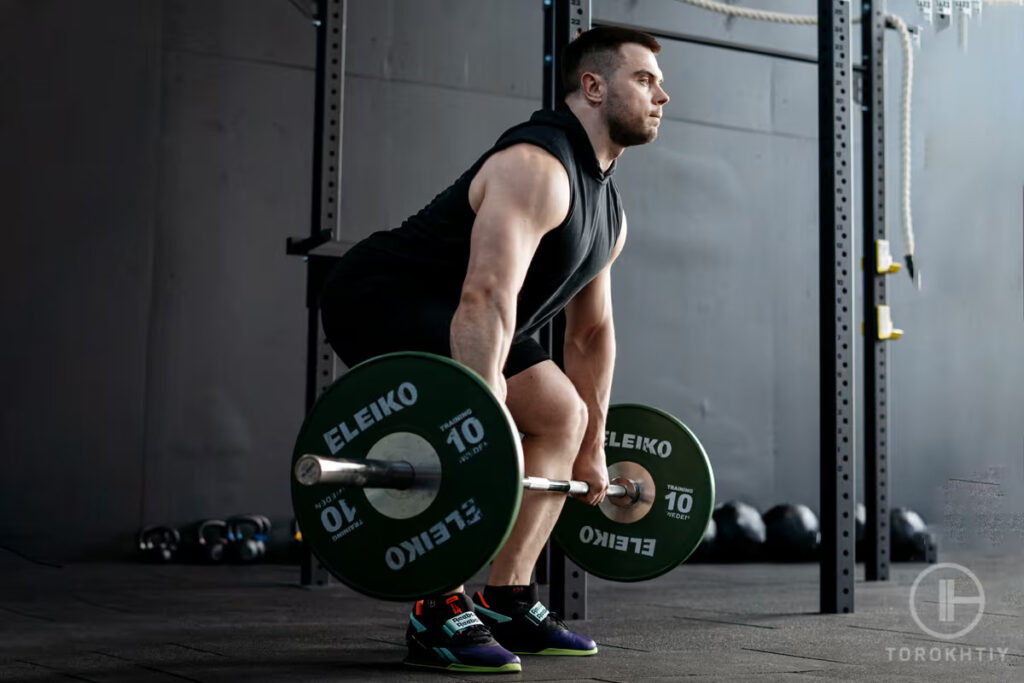
For those who like to spend the transition period with benefit, I have created a training program WEIGHTLIFTING BODYBUILDING. The goal of the WEIGHTLIFTING BODYBUILDING program is to train the main muscle groups in order to strengthen them and prevent injury. The program is 4 weeks long with 3 sessions per week + 1 optional technical training.
The training program is designed according to the scheme of the traditional 3-day weekly split: legs-shoulders; chest-triceps; back-biceps.
Both classic strength exercises and special exercises are used to strengthen the stabilizers and small muscle groups, which play an important role in the reliability of the weightlifter’s muscular system. A special stretching is planned to recover and relax those muscles that were involved at the end of each session.
The program includes ASYMMETRY exercises that are performed with an unevenly loaded bar (example: 5 kg disc on the left end and 10 kg disc on the right end). The purpose of these exercises is to develop coordination and strengthen the stabilizing muscles. Besides improving mechanics this also places more tension on the targeted muscles making it highly effective for hypertrophy training. Also this method will improve coordination and motor control.
Also, this period is perfect for recuperation from old or chronic injuries, and prevention. Therefore, the day schedule and nutrition program should be reasonably respected. It makes sense to pay attention to yoga, stretching and myofascial release.
With the right transition period construction, its optimal duration, the size of the load, the athlete not only fully recovers from the past year and gets set to work actively in the preparatory period, but also goes to a higher level of preparedness compared to the same period of the previous year.
In the picture below, I have shown which options on how to continue training after the WEIGHTLIFTING BODYBUILDING program I recommend.
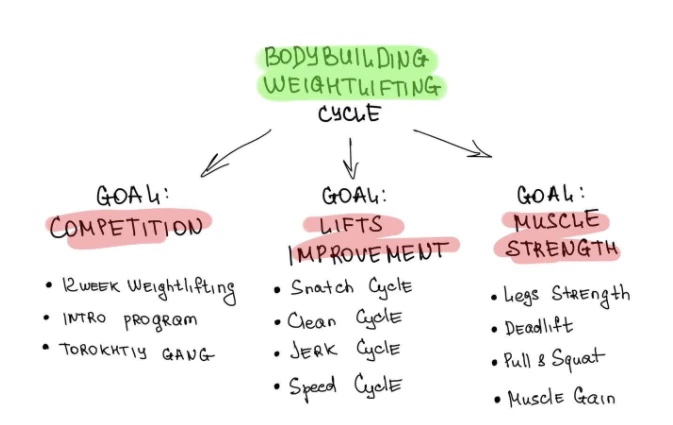
You can choose the programs that best suit your goals:
– preparation for the competition;
– specialized training cycles for the development of speed or one of the olympic lifts;
– strength programs for muscle growth and the development of strength in the legs and back.
You might be interested in:
Why Trust Us?
With over 20 years in Olympic weightlifting, strength training, nutrition coaching, and general fitness our team does its best to provide the audience with ultimate support and meet the needs and requirements of advanced athletes and professional lifters, as well as people who strive to open new opportunities and develop their physical capabilities with us.
By trusting the recommendations of our certified experts in coaching, nutrition, and sports training programming, as well as scientific consultants, and physiotherapists, we provide you with thorough, well-considered, and scientifically proven content. All the information given in the articles concerning workout programming, separate exercises, and athletic performance, in general, is based on verified data.
The product testing process is described in more detail here.
Author: Sergii Putsov
Head of Sport Science, PhD
Best Results: Snatch – 165 kg,
C&J – 200 kg
Sergii Putsov, Ph.D., is a former professional weightlifter and National team member, achieving multiple medals in the 94 kg weight category at national competitions. With a Master’s degree in “Olympic & Professional Sport Training” and a Sport Science Ph.D. from the International Olympic Academy, Greece, Sergii now leads as the Head of Sport Science. He specializes in designing training programs, writing insightful blog articles, providing live commentary at international weightlifting events, and conducting educational seminars worldwide alongside Olympic weightlifting expert Oleksiy Torokhtiy.



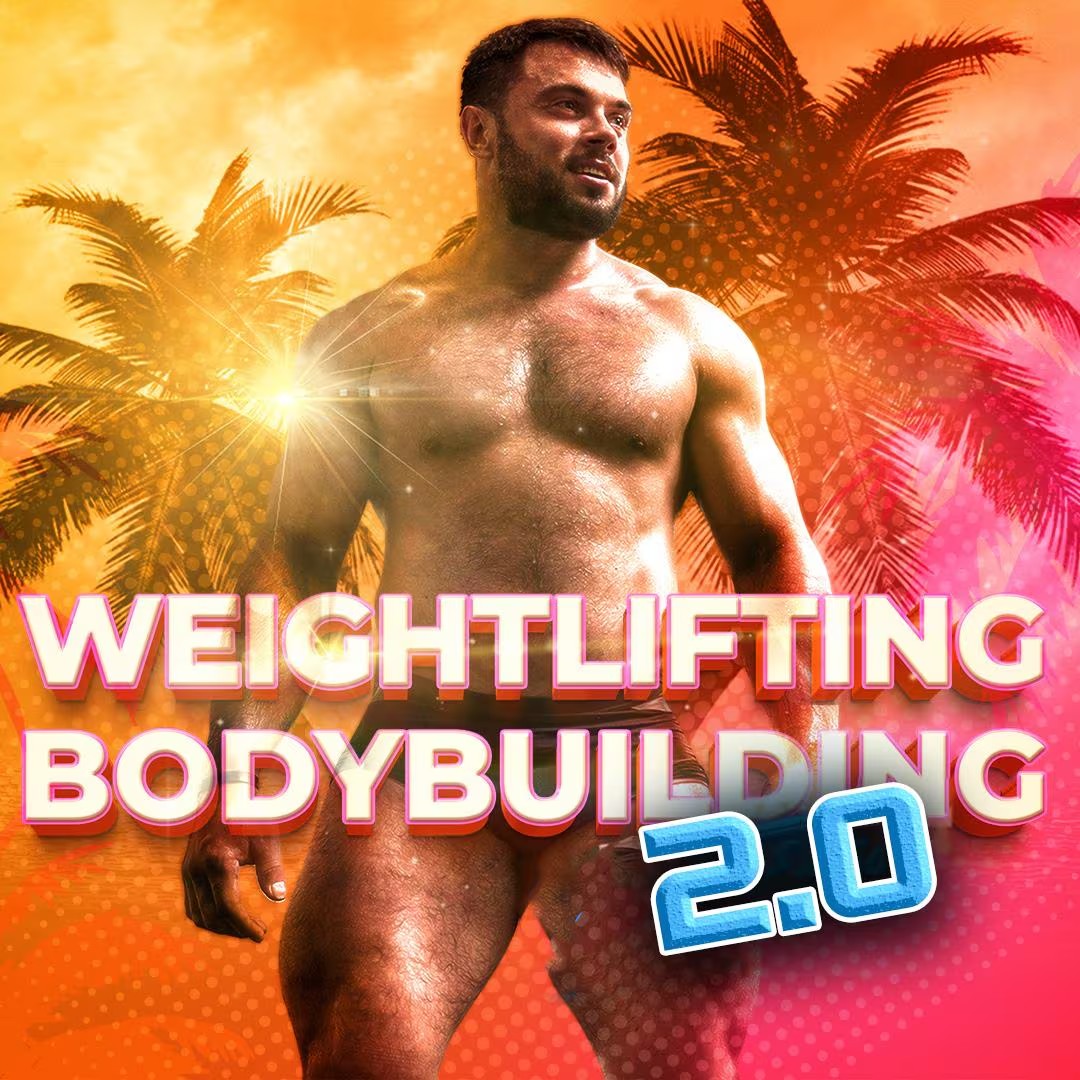
Still have questions after reading our article? Unlock your full potential by engaging with our experts and community! Don’t hesitate — leave a comment below and Sergii Putsov will provide a personalized answer and insights to help you reach your goals.